my funny valentine – petite lemon layer meringue cake
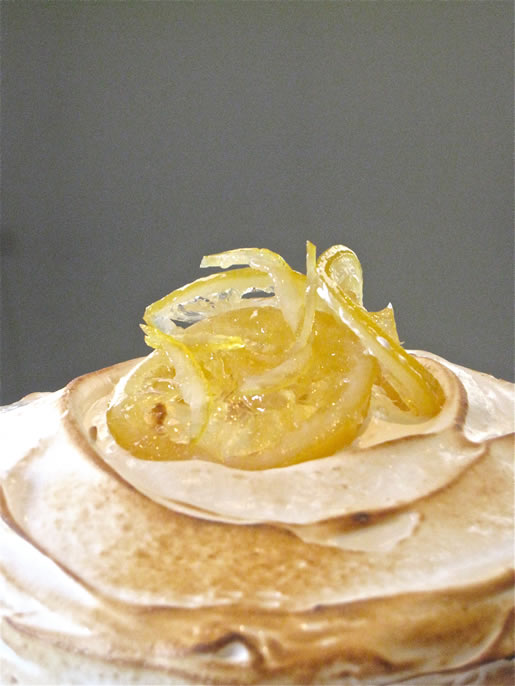
Every year as Valentine’s Day approaches, everyone seems obsessed by chocolate and red roses. I love both of them—and like to receive them—but if half the country is giving them and the other half is receiving them, how special are they, really?
I preferred to do something different and unexpected. This approach is part me and part M’s influence. We like to celebrate V-day on a date close to but not on Feb 14th. Other than New Year’s Eve, it’s the worst night to dine out, according to M, who dislikes most pre-fixe menus that restaurants offer on those nights–not to mention the predictable desserts. I have to agree with M that there have only been a few restaurants we’ve experienced on V-day that were enjoyable. Another reason that he’s not a fan of a pre-fixe celebration is that he’s a pescatarian (he only eats fish and seafood and no meat) which limits his choices on a set menu.
M’s favorite dessert is any kind of apple pastry or pie, but since we’ve been having lots of apple desserts over the holidays, I thought I’d change it up to another equally tantalizing fruit group. Citrus is a refreshing in-season antidote to all the chocolate treats. I came to imagine a billowy, elegant dessert with a complex sweetness and tartness—and a white cloud-like topping that suggests decadence. It would be a dessert ready to be a Cupid’s bow.
The solution is Petite Lemon Layer Meringue Cake — a multi layer white cake that’s delicate, with a spreadable lemony filling in between each layer. This sophisticated dessert is the opposite of a rich butter cake with lemon-scented butter cream frosting. Who wants to end a fantastic meal with a heavish dessert that would make you sluggish rather than ready to dance?
The multi-layer white cake is a cross between a yellow cake and a sponge cake. It’s lighter than a yellow cake but still has a rich flavor, and it’s sturdier than a sponge cake yet retains a light and fluffy texture. As for the filling—a perfect balance of lemon juice, eggs and butter puts this citrus out front. (A touch of gelatin mixed with lemon custard provides a silky filling that’s sturdy and spreadable.). Unlike a classic Seven Minute Frosting which has a candy-like sweetness, this dramatic meringue frosting doesn’t put you into a sugar coma. The lightness and glossy luster (from corn syrup) adds more visual texture to the final desert. Better yet, this frosting can last up to 3 days.
The components taste amazing individually, but when put together, it’s takes you to another level of satisfaction. This is a six-layer creation, which makes each bite that much more harmonious with a more even balance of lemon filling and cake. Another playful idea is to flame the meringue right before you serve it. The scent of burnt sugar will activate your V-mate’s curiosity.
Now that I have decided on dessert, I have to figure out what to make for the rest of the meal that comes before the Lemon Meringue Cake. One thing for sure, no steak.
1. Measure 1/2 tablespoon lemon juice into small bowl; sprinkle gelatin over top. Heat remaining lemon juice, sugar, and salt in medium non-reactive saucepan over medium-high heat, stirring occasionally, until sugar dissolves and mixture is hot but not boiling. 2. Whisk eggs and yolks in large non-reactive bowl. Whisking constantly, slowly pour hot lemon-sugar mixture into eggs, then return mixture to saucepan. Cook over medium-low heat, stirring constantly with heatproof spatula, until mixture registers 170 degrees on instant-read thermometer and is thick enough to leave trail when spatula is scraped along pan bottom, 3 to 5 minutes. Immediately remove pan from heat and stir in gelatin mixture until dissolved. Stir in frozen butter until incorporated. 3. Pour filling through fine-mesh strainer into non-reactive bowl (you should have about 1-1/2 cups). Cover surface directly with plastic wrap; refrigerate until firm enough to spread, at least 4 hours. 1. Adjust oven rack to middle position and heat oven to 350 degrees. Grease and flour two 6-inch wide by 2-inch-high round cake pans and line with parchment paper. Whisk together milk, egg whites, and vanilla, set aside. 2. In bowl of standing mixer fitted with paddle attachment, mix flour, sugar, baking powder, and salt at low speed. With mixer running at low speed, add butter one piece at a time; continue beating until mixture resembles moist crumbs with no visible butter chunks. Add all but 1/4 cup milk mixture to crumbs and beat at medium speed until mixture is pale and fluffy, about 1½ minutes. With mixer running at low speed, add remaining 1/4 cup milk mixture; increase speed to medium and beat 30 seconds more. Stop mixer and scrape sides of bowl. Return mixer to medium speed and beat 20 seconds longer. Divide batter evenly between cake pans; using rubber spatula, spread batter to pan walls and smooth tops. 3. Bake until toothpick inserted in center of cakes comes out clean, 16 to 18 minutes. Loosen cakes from sides of pans with small knife, cool in pan 10 minutes, then invert onto greased wire rack; peel off parchment. Invert cakes again; cool completely on rack, about 1½ hours. 1. Combine all ingredients in bowl of standing mixer or large heatproof bowl and set over medium saucepan filled with 1 inch of barely simmering water (do not let bowl touch water). Cook, stirring constantly, until mixture registers 160 degrees on instant-read thermometer, 5 to 10 minutes. Remove bowl from heat and transfer mixture to standing mixer fitted with whisk attachment. Beat on medium speed until soft peaks form, about 5 minutes. Increase speed to medium-high and continue to beat until mixture has cooled to room temperature and stiff peaks form, 5 minutes longer. Using icing spatula, spread frosting on cake. Serve. (Cake can be refrigerated for up to 1 day before serving.) Assembly 1. Use serrated knife to cut each cake horizontally into 3 even layers (you can make 2 layers, but increase filling to 1/2 cup per layer). Place bottom layer of 1 cake on cardboard round or cake plate. Using icing spatula, spread a little less than 1/3 cup lemon filling evenly on cake, leaving 1/2-inch border around edge; using cardboard round, gently replace middle layer. Spread a little less than 1/3 cup filling on top. Repeat till you place the top layer of the second cake on top. Smooth out any filling that has leaked from sides of cake; cover with plastic wrap and refrigerate while making icing.Petite Lemon Layer Meringue Cake
Ingredients:
Lemon Curd Filling
Cake
Meringue Frosting
Directions:
Lemon Curd Filling
Cake
Meringue Frosting

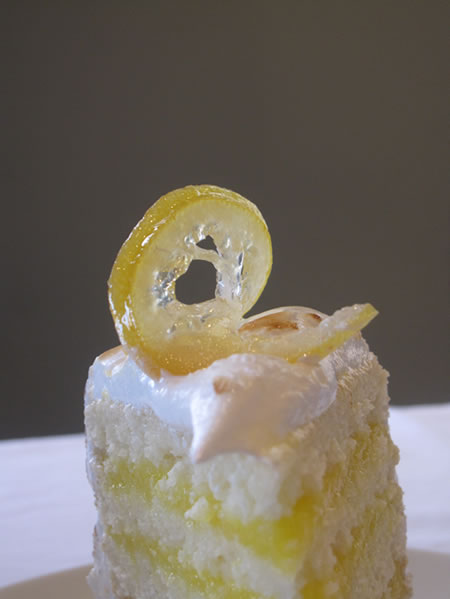
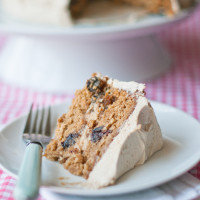
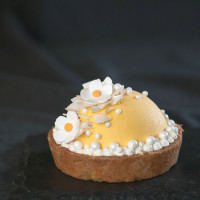

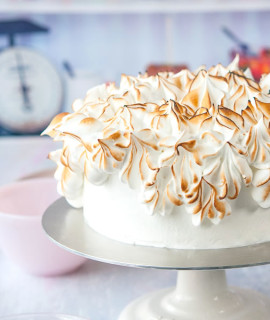
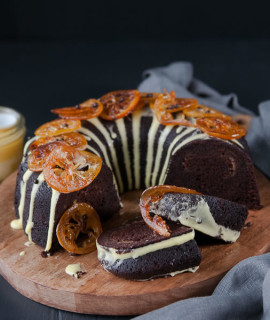
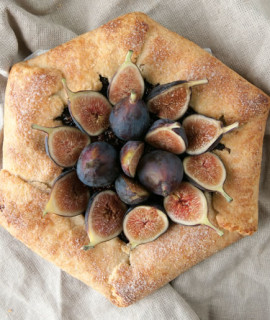
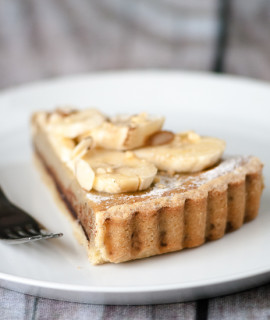
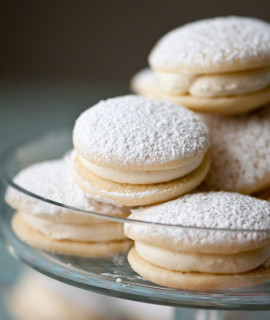
Hello Ken, I agree with your intro that roses and chocolate are not special anymore. I’d much rather get a cake like this one for Valentine’s.
Cheers,
Nisrine
thank you for sharing this!
Wow, beautiful blog, the design and photos are so clean and light. Yay for great new discoveries on Twitter!
Looks absolutely heavenly. Lemon Meringue Pie has always been amongst my top 10 favorite desserts – thanks to my grandmother’s incredible recipe – but I can’t say I’ve had it in cake form. Will clearly need to rectify that situation ASAP…
I’m measuring my sugar, and 3/4 C is only getting me 6 oz. That’s a large difference, so I wanted to double check which measurement to go with.
Hi Mariah, thanks for visiting my blog. I assumed you are talking about the Lemon Curd Filling. My standard of weight for granulated sugar is 7 ounces to 1 cup, so 3/4 cup should be 5-1/4 ounces. The weight was incorrect and I’ve revised it in the recipe. Thank you for pointing that out, much appreciated. -Ken
Ken, The icing for this cake is just beautiful! And it’s quite delicious, I enjoyed making it. Thanks for such a great recipe!
How many 6″ cake pans in MY pantry? Zero. Too bad, this looks fun to try but I’m not going to go out and buy yet ANOTHER pan.
Hi John, you can double the recipe and bake the cake in 9-inch cake pans for 20-25 minutes. -Ken